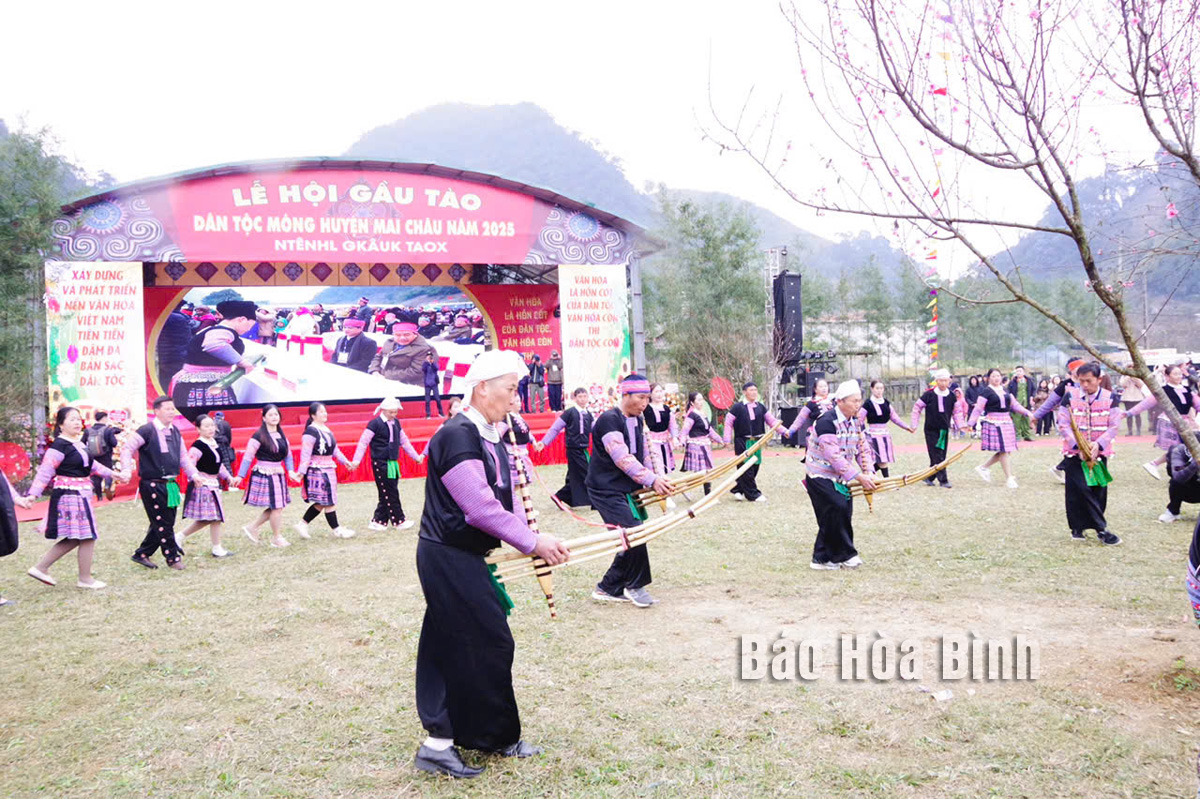
Gau Tao Festival, one of the most important traditional festivals of the Mong ethnic minority group in Mai Chau district was held at the Pa Co stadium in Pa Co commune on January 11.
Attending the festival were members of the Standing Board of the Hoa Binh Party Committee: Nguyen Van Toan, Permanent Vice Chairman of the provincial People's Committee; Vo Ngoc Kien, head of the provincial Party Committee’s Information and Education Board; and Colonel Do Thanh Binh, Director of the provincial Public Security Department. The event also saw Ding Cong Su, Vice Chairman of the provincial People's Committee; Dang Bich Ngoc, deputy head of the provincial delegation of National Assembly deputies; Colonel Trinh Duc Thiem, Commander of the provincial Military Command, among others.
The "neu” tree-planting and offering ceremony is the most important ritual of the Mong ethnic minority group’s Gau Tao Festival in the two communes of Hang Kia and Pa Co, Mai Chau district.
The Gau Tao Festival is a traditional folk festival, a long-standing cultural ritual and spiritual activity of the Mong people. In the two communes of Hang Kia and Pa Co, the festival has been revived since 2017. This year, the festival consisted of two main parts. The first part, the ceremonial activities, featured the key ritual of erecting the "neu” (bamboo pole) – a sacred symbol connecting heaven and earth. This part also included spiritual and cultural activities where offerings such as chickens, wine, rice, and paper were made to the "neu.” The ceremony leader lit incense, burned ghost money, and walked around the "neu” pole three times in a counter clockwise direction, then repeated the process while singing the "Tinh chay” song to announce to the deities that the "neu” had been erected, and to pray for a good year with favourable weather, bountiful harvests, and happiness and health for everyone.
As the festival drum sounds, the Mong people join in a traditional circle dance around the "neu” pole.
The festival includes a variety of exciting activities such as making sticky rice cakes, throwing "con” balls, tug-of-war, and more.
The festival also featured cultural performances showcasing the ethnic group’s identity, presented by young Mong men and women; tours of food, agricultural products, and unique items from the Mong community; traditional games like "pao” ball throwing, "tu lu” hitting, stilt walking, tug-of-war, and khen dance performances; sticky rice cake making contests; and traditional costume competitions.
Through the organisation of the Gau Tao Festival, the event contributes to the preservation, promotion, and honouring of the Mong ethnic group’s cultural heritage. Additionally, it enhances the introduction and promotion of the history, culture, and tourism potential of the two communes of Pa Co and Hang Kia to visitors. The festival fulfils the spiritual and cultural desires of the people in these two communes, fostering a healthy cultural environment and creating a joyful and optimistic atmosphere to welcome the Spring of the Year of the Snake. The Gau Tao Festival is closely linked to the worldview of the Mong people in the Northwest, reflecting their wishes for health, prosperity, favourable weather, abundant harvests, and growth.
The clothing of women reflects the culture of the Muong, Thai, Tay, Dao, and Mong ethnic groups in the northern province of Hoa Binh.
Gongs hold a special place in the cultural and spiritual life of the Muong ethnic people in Hoa Binh province. More than musical instruments, they are an indispensable part of community rituals and collective memory, echoing through generations as a spiritual thread linking the past, present, and future.
Preserving and promoting the cultural values of the Muong ethnic group has become an urgent task in the current context, as many traditional values face the risk of fading away. This effort requires not only protecting the cultural identity but also eliminating outdated customs and developing a modern cultural lifestyle, contributing to sustainable values for the Muong community in Hoa Binh province.
The Muong ethnic culture, deeply rooted in Vietnam’s mountainous north, continues to be preserved and revitalised by dedicated individuals and communities determined to safeguard their ancestral identity.
The Muong group is one of the largest ethnic minorities in Vietnam, primarily found in Hoa Binh province. The Muong people in Hoa Binh boast a rich and diverse cultural treasure that reflects the unique identity of this ethnic group. Accounting for over 63% of the province's population, they have created and preserved numerous distinctive cultural values, contributing to their unique identity. Their cultural heritage is an invaluable asset, at the heart of their national identity, and represents a vibrant spiritual life that must be preserved and promoted in today’s modern world.
For generations, the ethnic communities of Hoa Binh province, particularly the Muong people, have preserved vibrant festivals deeply intertwined with the region’s geography, nature, and social traditions. These celebrations enrich Hoa Binh’s spiritual life and cultural identity, reflecting both folk beliefs and the intermingling of ethnic customs. Many of these festivals have endured the test of time, passed down through generations and continuing to thrive today. Among them, the Khai Ha (Going Down to the Field) festival stands out as one of the most significant events of the Muong ethnic group.



